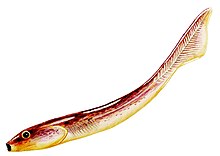Palaeospondylus
| Palaeospondylus Temporal range:
| |
|---|---|

| |
| Fossil on display at the Cincinnati Museum Center | |
| Scientific classification | |
| Kingdom: | |
| Phylum: | |
| Subphylum: | |
| Infraphylum: | |
| Genus: | Palaeospondylus Traquair, 1890
|
| Species: | P. gunni
|
| Binomial name | |
| Palaeospondylus gunni Traquair, 1890
| |
Palaeospondylus ("early vertebrae") is a prehistoric fish, a fossil vertebrate. Its fossils are described from the Achanarras slate quarry in Caithness, Scotland.
The fossil as preserved is carbonized, and indicates an eel-shaped animal up to 6 centimetres (2 in) in length. The skull, which must have consisted of hardened cartilage, exhibits pairs of nasal and auditory capsules, with a gill apparatus below its hinder part, and ambiguous indications of ordinary jaws.[citation needed]

The phylogeny of this fossil has puzzled scientists since its discovery in 1890, and many taxonomies have been suggested. In 2004, researchers proposed that Palaeospondylus was a larval lungfish.[1] Previously, it had been classified as a larval tetrapod, unarmored placoderm, an agnathan, an early stem hagfish, and a chimera.[2][3] A 2017 study suggested that it was a stem chondrichthyan.[4]
In 2022, researchers reported, based on studies using synchrotron radiation X-ray micro-computed tomography, that the neurocranium of Palaeospondylus was similar to those of the stem-tetrapods Eusthenopteron and Panderichthys, and concluded that Palaeospondylus was between those two phylogenetically.[5] Brownstein (2023) criticized this study, suggesting it would be basal gnathostomes instead.[6] Hirasawa and Kuratani, who are authors in 2022 study, replied to that and reviewed phylogeny again, resulted it would be closer to Acanthostega instead.[7]
See also
[edit]References
[edit]- ^ Thomson, K.S. (2004). "A Palaeontological Puzzle Solved?". American Scientist. 92 (3): 209–211. doi:10.1511/2004.47.3425. JSTOR 27858385.
- ^ Palmer, D., ed. (1999). The Marshall Illustrated Encyclopedia of Dinosaurs and Prehistoric Animals. London: Marshall Editions. p. 33. ISBN 1-84028-152-9.
- ^ Hirasawa, T; Oisi, Y; Kuratani, S (2016). "Palaeospondylus as a primitive hagfish". Zoological Letters. 2 (1): 20. doi:10.1186/s40851-016-0057-0. PMC 5015246. PMID 27610240.
- ^ Johanson, Zerina; Smith, Moya; Sanchez, Sophie; Senden, Tim; Trinajstic, Kate; Pfaff, Cathrin (2017). "Questioning hagfish affinities of the enigmatic Devonian vertebrate Palaeospondylus". Royal Society Open Science. 4 (7): 170214. Bibcode:2017RSOS....470214J. doi:10.1098/rsos.170214. PMC 5541543. PMID 28791148.
- ^ Hirasawa, Tatsuya; et al. (25 May 2022). "Morphology of Palaeospondylus shows affinity to tetrapod ancestors". Nature. 50 (7912): 109–112. doi:10.1038/s41586-022-04781-3. Retrieved 25 May 2022.
- ^ Brownstein, Chase Doran (2023). "Palaeospondylus and the early evolution of gnathostomes". Nature. 620 (7975): E20 – E22. doi:10.1038/s41586-023-06434-5. ISSN 1476-4687.
- ^ Hirasawa, Tatsuya; Kuratani, Shigeru (2023). "Reply to: Palaeospondylus and the early evolution of gnathostomes". Nature. 620 (7975): E23 – E24. doi:10.1038/s41586-023-06435-4. ISSN 1476-4687.
- This article incorporates text from a publication now in the public domain: Chisholm, Hugh, ed. (1911). "Palaeospondylus". Encyclopædia Britannica (11th ed.). Cambridge University Press.






